-
Posts
276 -
Joined
-
Last visited
-
Days Won
2
Content Type
Forums
Profiles
Gallery
Blogs
Downloads
Events
Posts posted by JETS
-
-
Hi JETS,
Thank you for your donation of --. We look forward to improving the forums with your donation.
Thanks VFRDiscussion
-
On 2/17/2021 at 5:42 AM, Dutchy said:
From this side of the pond i'd say you have already passed the point of no return.....
Selling -as a whole or in parts- will never yield more than you already poured in. Let alone the hours...
2 grand for a 4th Gen that is cosmetically challenged? No way José...
The part you spent the most on is the LEAST valuable.....
In the unlikely event a current owner will need a spare engine, 250 is about the going rate..
After totalling my 4th gen in 2016, the "high" value items were:
-8 spoker rear wheel with single nut cover
-front rim (desired by 1st gen CBR900 owners)
-Akrapovic carbon high mount
-pristine bodywork (from the attic)
-Wilbers rear suspension
-MOSFET regulator
-re-jetted carbs+K&N airfilter
-re-upholstered seat
Last summer I recommissioned a 4th gen and installed things like
-New YSS rear shock
-White Power front springs
-pristine OEM muffler
-New HEL brake lines
-new front wheel bearings
-OEM Y2K mirrors
-New Dunlops
-ALL fluids changed, brake calipers serviced
-Pristine bodywork
"best" offer was Euro 1,400 (he was "doing me a favor" he stated). He never even wanted to come out and see the bike in real life...
I gave the bike to my brother and his daughter. They happy, me happy...
Dutchy Dutchy, I am so glad to see that you get another GEN four. I was so upset when I saw you had lost yours. I haven't been on much due to some family issues, but I still have my 97 and can't imagine a better bike no matter what I read about. Keep the faith my man. NACA ducts forever!
-
 1
1
-
-
Hi JETS,
Thank you for your donation of --. We look forward to improving the forums with your donation.
Thanks VFRDiscussion
-
Man, for the utility it provides, and the miniscule percent of weight it is, I'd retain it. My 97 would have been a pain in the butt to maintain all these years without it.
-
 1
1
-
-
Hi JETS,
Thank you for your donation of 10.00 USD. We look forward to improving the forums with your donation.
Thanks VFRDiscussion
-
Hi JETS,
Thank you for your donation of 25.00 USD. We look forward to improving the forums with your donation.
Thanks VFRDiscussion
-
Yeah, the gray magic works most of the time. I've sure been the beneficiary of it out and away from home. Now if the little gray cells will just hang in there! Dang, now what did I come in here to do before I stopped to check the VFRD traffic????
-
Let's say that she'll be a real head-turner. I think it's pretty ballsy, but make sure to get the "easy peel" variety. It might be like waking up with an ugly girl one morning and wonder what the hell was I thinking!
-
Anyone in range of Austin, consider volunteering to be a track marshall next spring when MotoGP comes around again. I did so this round, and though it was long hours and a lot of standing at trackside ready for action, it was a blast! I was right across from Lorenzo tossing it in practice, and just a turn away from a serious event that got med-evac'd. It is a privilege to be mere feet away from all the famous riders as they rip by at full throttle, ones you have only watched at a distance before.
I was a medic, who assists an EMT to provide immediate assessment to a fallen rider. Others were track marshalls, who deploy barriers, haul crashed bikes, and put out fires---all of which was done at COTA. One can also man a flag station, attend the grid line up, or do tech checks in the garages, and more. All positions are trained by the staff, and experienced staff provide a backbone to the volunteers. The COTA team provides 3 meals, drinks, ice, and transport onto the track from a central base parking area that is free to volunteers. You also are allowed to walk the pits at certain times. You are appreciated and treated very well.
You want to know what it's like to be on the inside of the fence and on international TV? Just sign up next year!! I dang sure will be.
-
Dirt loves to find the small jets and transfer passages in the low speed (low RPM) circuit. Apparently more so with ethanol crud forming now. Look for the cool pipe and chase out the "off idle" low speed jet and the tiny holes by the idle mix screw. Above idle, but below the speed where the needle jets start to govern fuel flow, the small holes in the carb throat that are by the butterfly allow more fuel to flow and accelerate the engine. Fine copper or brass wire is safe to push in the passages and jets, but never steel, welding tip cleaners, or drill bits. Typically the RPM range affected is about 2000-3000. That is, if idle is good. If the whole idle circuit is blocked, then even idle is affected. The intermittent nature of your problem at low loads and low RPM, coming off corners, I think you said, suggests something that can move around. Getting temporary relief by incessant carb cleaning also suggests it. Be sure your fuel lines and filter are new and clean. The low speed circuit has an air bleed jet that also needs to be cleaned and checked, as it is a channel that you could blow crud from the fuel passage back into, only to have it eventually migrate back into the idle and low speed path.
-
I bought a Fox Twin Clicker for a CBR and had Fox revalve it for the VFR, changed the spring (HyperPro), and added a spacer to get the length just right. It has been a champ.
Also you might pick the brains of Baileyrock or JamieDaugherty on the VFRD.
-
Had a great loop last week, originally planning to head up the Million Dollar Highway, 550, out of Durango, but rain was imminent and we knew that it would spoil the mountain passes and the curvy roads, so reversed the direction and went southwest to Arizona and up Monument Valley.
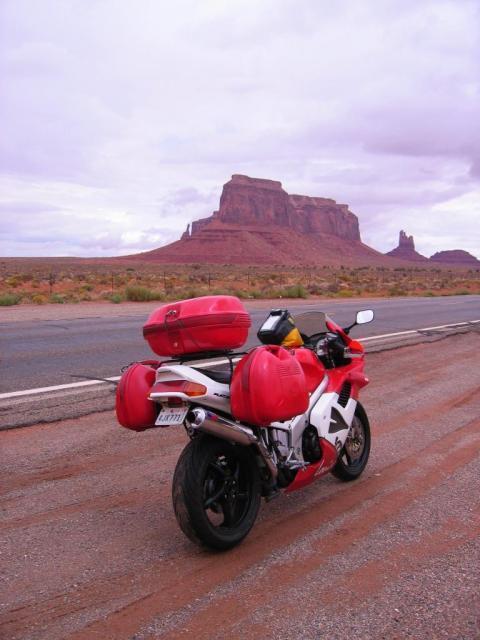
After snagging the ONLY battery for an SV650 in Kayenta, we belatedly hit the road north. FYI, reserve a room in Kayenta; they don't have a lot of rooms and at a late hour they double their rates. Ask me how I know.
Spitting rain up from Kayenta gave way to more continuous showers, but the desert had a mystery about it in the hanging mists and cloud cover. The smell of the moist desert was like incense, completely different from other earth aromas after rain.
The rain was never too heavy, but it buffaloed the cars and trucks, so we leap-frogged lines of them in the open places. Exhilarating to hit a few digits in the rain, but wet trackdays have given the parameters of confidence needed to be safe on clean wet pavement.
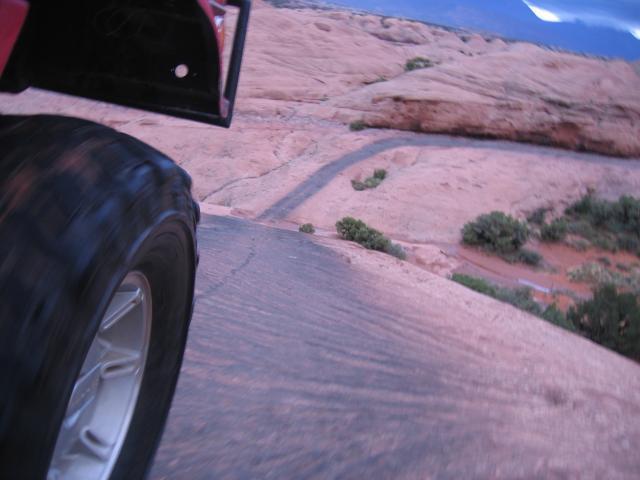
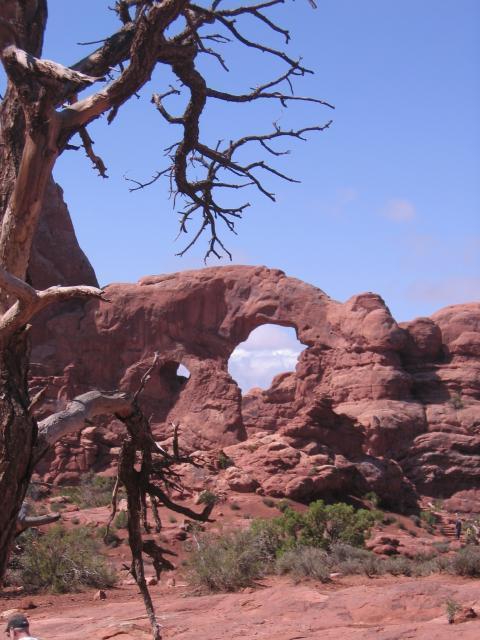
Utah was washed clean by heavy rains as we approached Moab, so the rainbow sunset was spectacular when we took a Hummer ride up onto the Slickrock formations above the city.
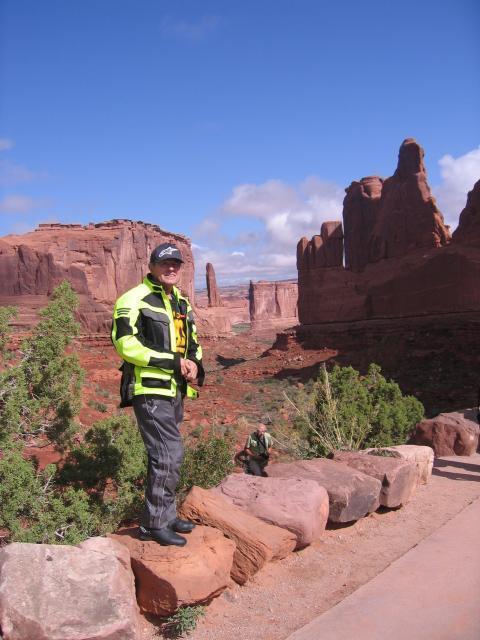
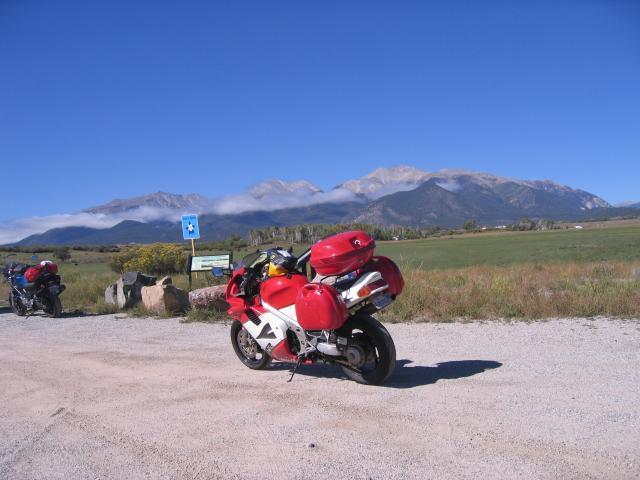
Waterfalls cascaded where it is usually bone dry, and the HumVee (real deal Hummer, Army grade) didn't give a flip about fording the hub deep stream beds or the 45 degree rock.
We toured the Arches National Monument.

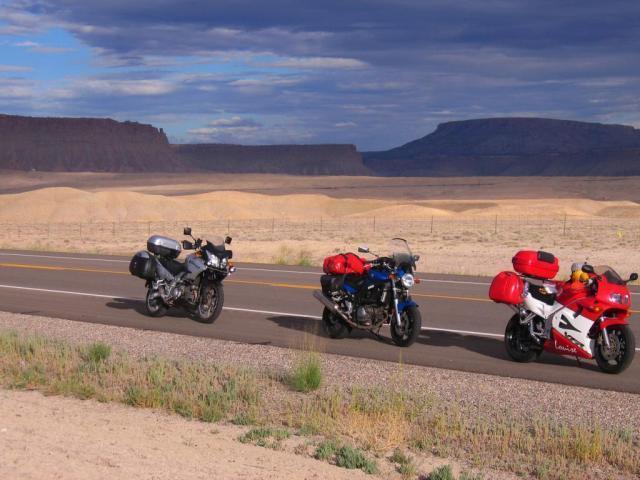
Then followed 128 up the Colorado through the darkly varnished canyons, crossing to the more arid flats and past Cisco, the abandoned water stop on the rail. Eerie, that.
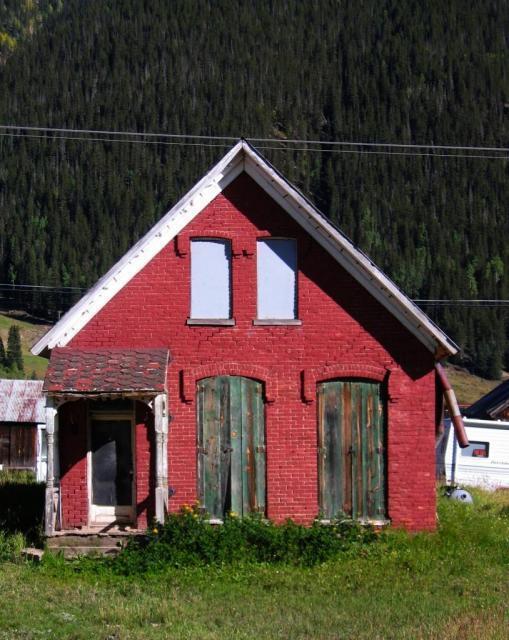
The farm country of Western Colorado yielded a path up through Rangely and to Meeker for a night. The White River Valley west of Meeker was just spectacular and verdant, but the road too narrow and winding to allow a quick pull-off for photos.
Steamboat was the northernmost town for us, then we wiggled back south over Rabbit Ears and Freemont passes, past Leadville and into Buena Vista.

A fall chill had arrived and we left in 38 degree temps to cross Monarch Pass, snugging up our collars even in full sun.
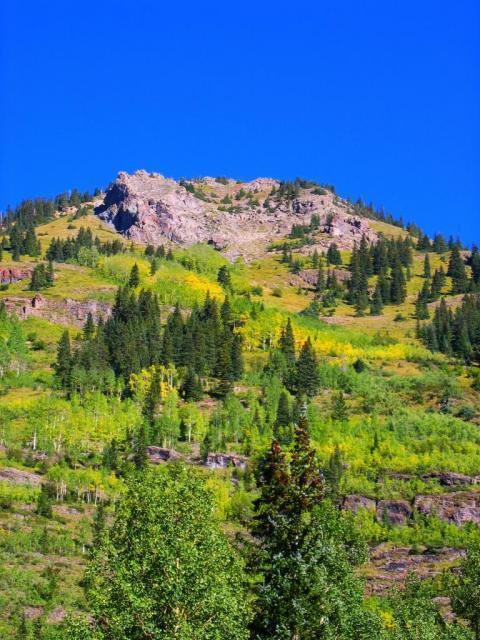
We came down the Million Dollar through Ouray and over Red Mountain Pass to Silverton, where we stopped to see the town.
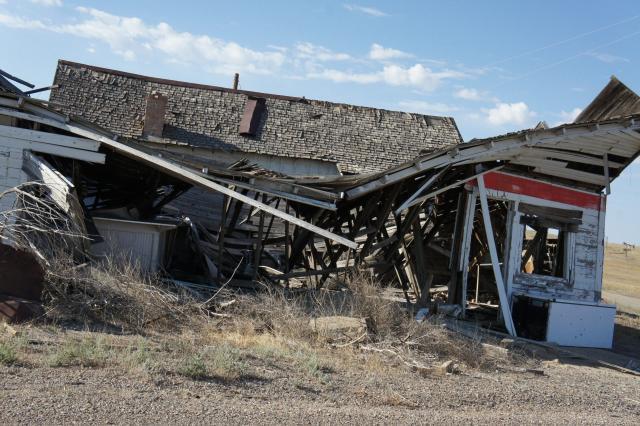
Then we topped Molas Pass to hit Durango and crash into some good college town food and drink.
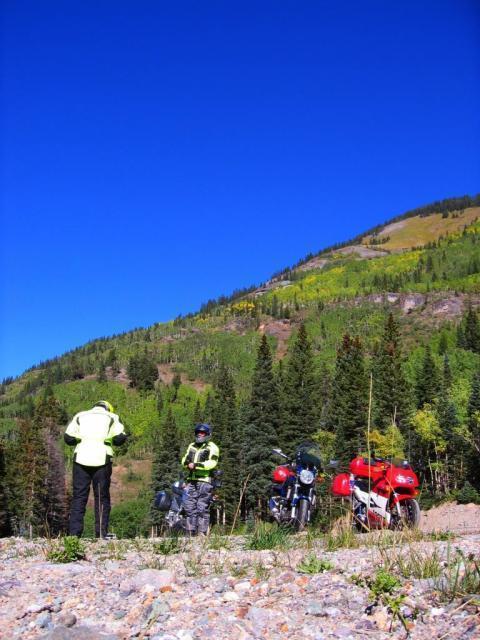
I chose to hit motels randomly so as to have destination flexibility, but since there are no alternatives in the vicinity of Moab, and now Kayenta, plan accordingly.
One bike had a battery fail, and a ten year old V-Strom 1000 dropped all its turn signal stems, but 5-minute epoxy clay and coat hanger made them last the whole 1100 miles. Louise, however, maintained her perfect record, having never let me down for a moment of anything. Yea Gen Four!
-
6.3 makes generational sense
-
Morgan, read up on ABS repair. Regular Bondo is not going to adhere well and some of your hard work, once painted at cost, may crack. peel, split. Here is a link, and they sell an excellent book on how to repair ABS, highly recommended. http://www.urethanesupply.com/howtorepair.php
I've done it all, and if you follow good technique, there is no reason you can't come out with great results!
I'm glad you are so into fixing up this classic bike. Good on you.
-
Yeah! That's some class work you have done there! This must not be your first rodeo. I love the perfecting of the already perfect 4th gen.
-
Thanks guys. I've done a lot of practise braking on my bike already - all straight stuff though. At both low and high speeds. And you're right - you can easilly get the back wheel in the air even with the linked braking. :)
I was taught never go faster than you're willing to emergency brake - so braking was the first thing I practised.
Gee - I've got more than I bargened for out of my original post wanting to know whether or not it's OK for me to use the bike leaning and not just myself - but it's all good stuff to think about. :)
As for a twist of the wrist, I've read the first book and wasn't really impressed. Seems that most of the writing was race track related. From what I gathered, the lines in that book would help to kill me on the open road. The last place I want to be on a blind corner at the apex is right at the centre of the road. The message I kept getting from the book was how to improve my track time and get through corners quicker, not how to take the corner safer. I'm sure that it's a good book if I want to get into track racing, but I'm just not interested in that sort of riding.
One book I have come across that I liked a lot was Motorcycle Roadcraft. That was more about surviving the roads with the additional hazards that we face on a daily basis, and IMO had much better cornering lines for the open road. Before I order Total Control, is that more like 'A twist of the wrist' or is it more suitable for what I'm looking into?
Twist of the Wrist's best part is the enumerating and explaining of the survival reactions that await one if not anticipated and countered with proper training and practice. I like Nick Ienatch and his book, too, the author of "The Pace" years ago, and the recently published update. Lee Parks did a good job on his course and has good photos that demonstrate well.
I can say from personal, regrettable experience that hitting the rear brake in an urgency is most likely to result in over-use and a rear slide that ends in a highside. Standing the bike up a bit and braking with the front can slow you to a safe cornering speed in microseconds and allows re-leaning the bike to complete the turn or avoid an object. Recall that the front brake use lightens the rear and leaves little retarding force at your disposal.
Track days and their lessons are hugely useful in learning to perfect good riding control and will enhance just exactly what you say you want out of your road riding. I vouch for it personally.
Good riding in Oz!
-
As long as the EPS has not deteriorated, the foam is ok to re-pack. It contributes fit, comfort, and wind seal, but virtually nothing to brain protection. The EPS absorbs the impact G's by crushing, reducing energy transmission to the skull. The shell averts penetration and distributes the forces to a larger area of the EPS. More flexible shells, like the composite HJC's actually perform better than very rigid "old Snell" spec helmets in reducing force absorbed by the skull and the resultant brain acceleration/ deceleration. Don't feel bad that you have done a clever job. And the HJC is a perfectly good helmet brand. Ask Ben Spies.
-
I think all the theorizing will blow up if and when the Euro only VFR800 version appears in the market here. I think there is a pent up demand for a modernized VFR800( and wished for 1000),that appeals to folks who have experienced VFR in all the first six generations, but are "buffaloed" by having no new VFR choice but the 1200. There is always a crackle of excitement when the new 800 is mentioned or is shown in a mag. One wonders who in Hades at Honda makes the market release calls.
-
Yep, these bucket lists are killin' me.
-
Looks like leaky or incorrectly shimmed cartridge, or blown lower cartridge rod or upper free piston seals. Compression damping is not taking place. Go back through your assembly steps and look for some error.
-
Vanson suggests using Pledge for cleaning their gear. Good enough for me and my Vanson's.
-
I was interested in this topic also, and in looking around, see that the DOT specs for an H4/9003/HB2 bulb is 1580 lumens. It seems that the visible light power output of the LED you installed is the same as a stock H4, but with a very narrow color wavelength, making the apparent brightness better, which is what you were after in the first place.
There are offerings of higher power LED's I saw, up to 3200 lumens (lumens being the power, or wattage, of visible light emitted), if you want more light.
The wattage consumed by the device to emit that much light is lots less for LED's than filaments of any kind, yet if you go up in light power, you will need more current, but still significantly less than halogen filament bulbs as are stock. LED's are about 15% efficient, meaning 85% of power applied is lost as heat (therefore the heat sink and fan, to prevent overheat damage to the LED).
Standard halogens emit 5% of power applied as light, and get quite hot, but it doesn't hurt them.
There is an issue of reflector design and the size of the light "point" of an LED, and how that point aims and spreads through the parabolic reflector of a stock lens. The LED light emitter is much large than the precise filament of an H4, and will bounce more stray rays outside the reflector and lens envelope's design.
Only by installing and observing for yourself can you judge scatter and glare. One would have to set up a bike with a rider posed at normal riding position and go away far enough to see what other drivers see facing you. Ideally, by sitting in a car as though meeting you on the road.
I would be interested in how you perceive the oncoming cage driver's view. Thank you for making a nice post of the install and for all the trouble you went to in making it available on this forum.
-
Considering that winter has befallen my home town and weather shall not be overly conducive to riding for a little while I shall not be able to really test out the new lights for a while to come. When I took the photos with two bikes side by side the weather was about -15*C and thus not very good for riding. That being said I did take my bike for a spin a little while later in the early evening after it warmed up a bit and the lights did make a WORLD of difference. A lot more light is cast ahead of the bike, including a fair bit more on the ground directly ahead of the bike. The area in front from about the tire to 4 feet ahead there is more light than I ever remember there being. The extra light here is not annoying at all and I really quite like it. The area from about 5 ft to say 30 feet is filled out nicely and there is definitely more, and brighter light than ever before. There also appears to be a lot more light to the sides of the road (contrary to theory that the LED's only have a 125 degree spread and that I will be missing 55 degrees of light to the side, must be extra diffusion off the reflector) and since the light is whiter, I find the color contrast makes objects being illuminated to be much easier to see. Not really sure how to describe this, sort of something one must see to understand. If you have ever driven a car with HID headlights, or one of the new models with LED headlights you may understand but everything the headlights illuminate just seem easier to see.
This is all after only a short (maybe 30 km's) 20 minute ride. In the whole time, I had not one high beam flash, and not one person ahead of me was seen to be dimming their rear view mirror, and I paid close attention to this as with most vehicles without tinted window it is relatively easy to see someone adjust the mirror. I also paid close attention to the where the light beam was being cast on the vehicle directly ahead of me, and how far the headlights of the cars beside me cast their headlight beams. From fairly quick first impressions on the road, the amount of light being cast is fairly similar to a current body style BMW M3 hard top convertible, as I was riding beside one down the highway for a short period.
One thing I never mentioned in my original post is that the garage shots were done on different days, and the LED headlight photos were done with the bike about 2 feet further away from the door as I had to move the bike back to get to the power panel in the garage when a circuit breaker tripped. This would likely account for the main difference in the height of the cut off line. Apparently I had a few too many Christmas lights plugged into the outlet on the front of the house. Oops, my bad.
A lot of people in my home town of Kelowna are in the over 65 year range and most of the seniors are VERY quick to flash their high beams at you if they protest your bright lights. There are also a LOT of younger guys in town that work in the oil patch and drive highly lifted, newer model 4x4's, and with their headlights being an extra 10 inches higher off the ground, they are glaringly bright even in stock form as they are nearly eye level when you are driving. As a result, most people are used to flashing their lights at you if you accidentally leave your high beams on when you come of the rural side roads that are unlit and head in to town where there are street lights. There is a guy living in the apartment block just a half block from my house with a 2005 VFR who has converted to full HID's and he says he is ALWAYS getting flashed. He said if it wasn't for the fact that the factory harness is now all chopped up he would go back to stock headlights.
When my wife came outside with me to flick the switches on the headlights from Low to High for me she made an interesting comment. She turned on her headlights (no comment) and when I turned on the new headlights on my bike her comment was "Shit, my headlights SUCK. You were planning on doing the same to my bike, right?" Naturally my response was the same any happily married man would make, "Why, Yes dear!!" LOL. Seriously though, my wife, who normally does not pay a huge amount of attention to adding farkles to her bike was definitely on board with a headlight upgrade. Even with stock bulbs in the headlights (Sylvania Silverstar H4 bulbs in both bikes by the way) she commented that the headlights on her bike were not quite as bright as the stock headlights on my bike. This may in part be due to the fact that the 5th gen has a completely clear headlight lens whereas the 4th gen is not totally clear.
Am I happy with them, YES, I would have to say overjoyed at this point. Hopefully biking season this year is not far away and I can provide some more comparisons, but for now, I will have to wait till winter ends. I have ordered a second kit for my wife's bike (96 VFR) and plan to retrofit her headlights as well. When I finished I will definitely post up some before and after photos and I will be sure to be more careful about leaving the bike in the same position so that there is a more accurate depiction of the difference.
Hope everyone has a great New Year and all the best.
And you get the award for being calm and cool in the face of rampant criticism from the not-here-to see-it, haven't actually-tried-it theorist. It is kind of like the French joke: "I see it works in practice, but does it really work in theory?"
-
Bad battery.........you can get voltage stored, but little current capacity. You use your scant number of amp-hours (prolly milliamp-hours now) in a few seconds. Power to start the bike is volts x amps, so 13.5 x 2-3 (guessing) is 25-40 watts, just enough to light a bulb, but DOA for turning it over to start. I have chased this one down before, too. It's amazing how a battery can fritz from one day to the next.


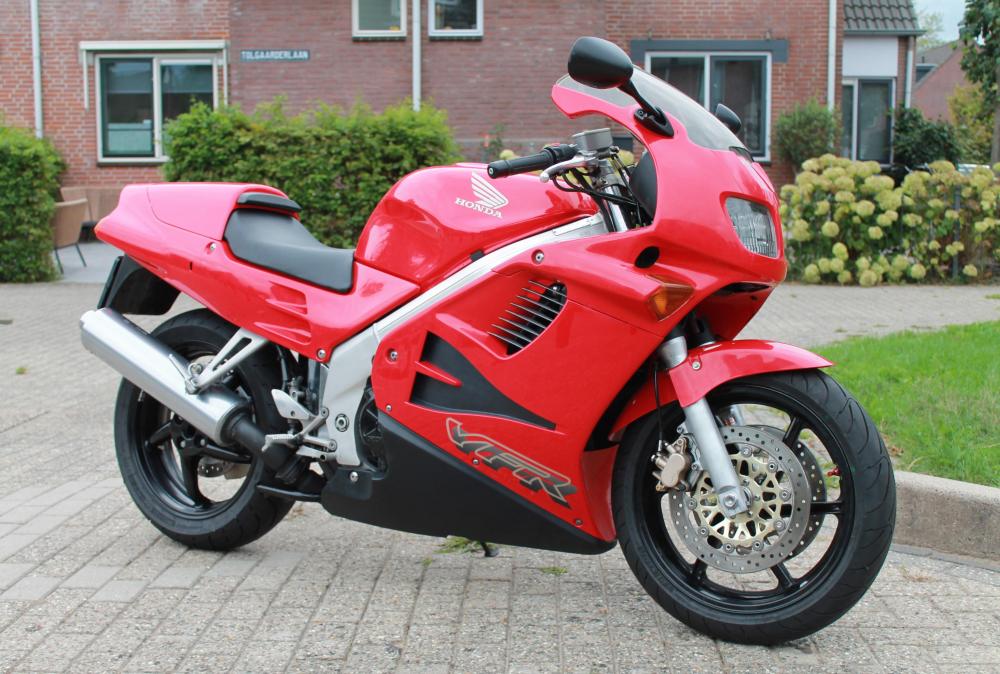




Finally done
in Third and Fourth Generation VFR's
Posted
Great job, nice bike, and kudos to preserving one of the best motorcycles ever made.